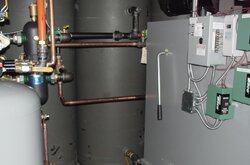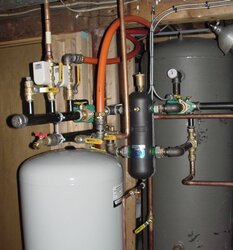Just finished up the last few bits (except insulation) on an experimental install.
Boiler is a Fröling Turbo 3000, 50kW, connected to three 220-gallon pressurized storage tanks (660 gallons total storage).
BioHeat was interested in getting some practical feedback on the installation of these boilers prior to finalizing the manual and shipping them to customers, so we worked out a deal to get a boiler a bit early and provide them with that.
This was a particularly-good application for such an experiment, as we have a number of things going on all at once. The original house was heated by an oil-fired forced-hot-air furnace, and we've disconnected the burner on that, but continue to use the blower with a heat exchanger in order to provide heat through the existing ductwork.
There is an addition on the house which uses an oil-fired boiler to operate in-floor radiant heat. We tied into the primary loop on that boiler and ran the 30 feet back to the wood boiler (installed next to the disconnected oil furnace) with pex-al-pex. That connection is set up to allow bi-directional heat transfer, so the wood boiler system can send heat over to the radiant zones, or the oil boiler can send heat over to the furnace heat exchanger. The piping is simple for that, but the controls are a wee bit more complex than the norm, since there are four states of operation (oil boiler heating its own zones, oil boiler heating furnace heat exchanger, wood boiler heating furnace heat exchanger, wood boiler heating oil boiler zones).
Since the purpose of this project was to provide an experimental platform, we did a few other things interesting. First was to install the power-failure zone valve on the return side of the system, bypassing the Termovar and pump. In a power failure, the valve springs open, allowing gravity convection from the boiler to the tanks, which should have more than enough ability to absorb the small amount of heat that the boiler will contain. It should be noted that the Fröling boilers run on 220V, and the pumps/controls run on 120V - the zone valve is connected to the pump circuit, so that any failure there will allow for convection. The Fröling boiler has a manual-reset overheat sensor which shuts the boiler down in an overheat situation.
The zone valves for the zones are Caleffi motorized ball valves, which draw extremely little power to operate (4 VA), although it should be noted that they are power-open and power-close, so you need a control that can supply both signals, rather than the typical power-open and spring-close control strategy. They also provide extremely little flow restriction, which can be helpful.
A Ranco ETC provides tank temperature display, as well as switchover from wood to oil backup. The Fröling also has a pair of tank temperature sensors (upper and lower), allowing it to operate its own pump. It also has a boiler-temp sensor, a flue-temp sensor, and, of course, the oxygen sensor.
It's been an interesting install, given the number of items we were experimenting with, as well as the "compact" space we had available (even after the homeowner was kind enough to move a wall to increase the space we had to play with), and they've been more than kind in putting up with some unavoidable delays due to backordered material, as well as odd hours tinkering with the project to get it right.
I have a whole list of notes for BioHeat, which will hopefully help others install these boilers in a much-smoother manner, but the biggest note I would like to make publicly at this time is that the Fröling has a powerful induced-draft fan. Particularly when it speeds up an additional 15-20% while the main door is open (to capture smoke). A quality flue is a must. We're only dealing with a ranch, here, and pushing gasses up one storey of 6" square tile chimney is enough of a backpressure to cause significant smoke leakage from any available gap. Large quantities of RTV silicone has stopped that, but all future installs I do will only use stainless chimneys (or a continuous stainless liner in the tile chimney), or will at least include a disclaimer than lining the chimney may be required, after the system is tested. Of course, the Fröling boilers are not exactly cheap, so the added cost of a bit of chimney liner is not a huge change in the job price.
It's an impressive piece of equipment, though, and I can't wait to get one for my own house/shop. I'm getting sick of paying the oil man, but I need to do some significant remodeling and structural improvements before I can install the boiler in the intended location, so that will have to wait a bit. For one thing, I need to pour a footing to support the storage tanks, and I don't want to try that during the middle of the winter.
I should have some pictures to post in a couple days.
Joe
Boiler is a Fröling Turbo 3000, 50kW, connected to three 220-gallon pressurized storage tanks (660 gallons total storage).
BioHeat was interested in getting some practical feedback on the installation of these boilers prior to finalizing the manual and shipping them to customers, so we worked out a deal to get a boiler a bit early and provide them with that.
This was a particularly-good application for such an experiment, as we have a number of things going on all at once. The original house was heated by an oil-fired forced-hot-air furnace, and we've disconnected the burner on that, but continue to use the blower with a heat exchanger in order to provide heat through the existing ductwork.
There is an addition on the house which uses an oil-fired boiler to operate in-floor radiant heat. We tied into the primary loop on that boiler and ran the 30 feet back to the wood boiler (installed next to the disconnected oil furnace) with pex-al-pex. That connection is set up to allow bi-directional heat transfer, so the wood boiler system can send heat over to the radiant zones, or the oil boiler can send heat over to the furnace heat exchanger. The piping is simple for that, but the controls are a wee bit more complex than the norm, since there are four states of operation (oil boiler heating its own zones, oil boiler heating furnace heat exchanger, wood boiler heating furnace heat exchanger, wood boiler heating oil boiler zones).
Since the purpose of this project was to provide an experimental platform, we did a few other things interesting. First was to install the power-failure zone valve on the return side of the system, bypassing the Termovar and pump. In a power failure, the valve springs open, allowing gravity convection from the boiler to the tanks, which should have more than enough ability to absorb the small amount of heat that the boiler will contain. It should be noted that the Fröling boilers run on 220V, and the pumps/controls run on 120V - the zone valve is connected to the pump circuit, so that any failure there will allow for convection. The Fröling boiler has a manual-reset overheat sensor which shuts the boiler down in an overheat situation.
The zone valves for the zones are Caleffi motorized ball valves, which draw extremely little power to operate (4 VA), although it should be noted that they are power-open and power-close, so you need a control that can supply both signals, rather than the typical power-open and spring-close control strategy. They also provide extremely little flow restriction, which can be helpful.
A Ranco ETC provides tank temperature display, as well as switchover from wood to oil backup. The Fröling also has a pair of tank temperature sensors (upper and lower), allowing it to operate its own pump. It also has a boiler-temp sensor, a flue-temp sensor, and, of course, the oxygen sensor.
It's been an interesting install, given the number of items we were experimenting with, as well as the "compact" space we had available (even after the homeowner was kind enough to move a wall to increase the space we had to play with), and they've been more than kind in putting up with some unavoidable delays due to backordered material, as well as odd hours tinkering with the project to get it right.
I have a whole list of notes for BioHeat, which will hopefully help others install these boilers in a much-smoother manner, but the biggest note I would like to make publicly at this time is that the Fröling has a powerful induced-draft fan. Particularly when it speeds up an additional 15-20% while the main door is open (to capture smoke). A quality flue is a must. We're only dealing with a ranch, here, and pushing gasses up one storey of 6" square tile chimney is enough of a backpressure to cause significant smoke leakage from any available gap. Large quantities of RTV silicone has stopped that, but all future installs I do will only use stainless chimneys (or a continuous stainless liner in the tile chimney), or will at least include a disclaimer than lining the chimney may be required, after the system is tested. Of course, the Fröling boilers are not exactly cheap, so the added cost of a bit of chimney liner is not a huge change in the job price.
It's an impressive piece of equipment, though, and I can't wait to get one for my own house/shop. I'm getting sick of paying the oil man, but I need to do some significant remodeling and structural improvements before I can install the boiler in the intended location, so that will have to wait a bit. For one thing, I need to pour a footing to support the storage tanks, and I don't want to try that during the middle of the winter.
I should have some pictures to post in a couple days.
Joe




